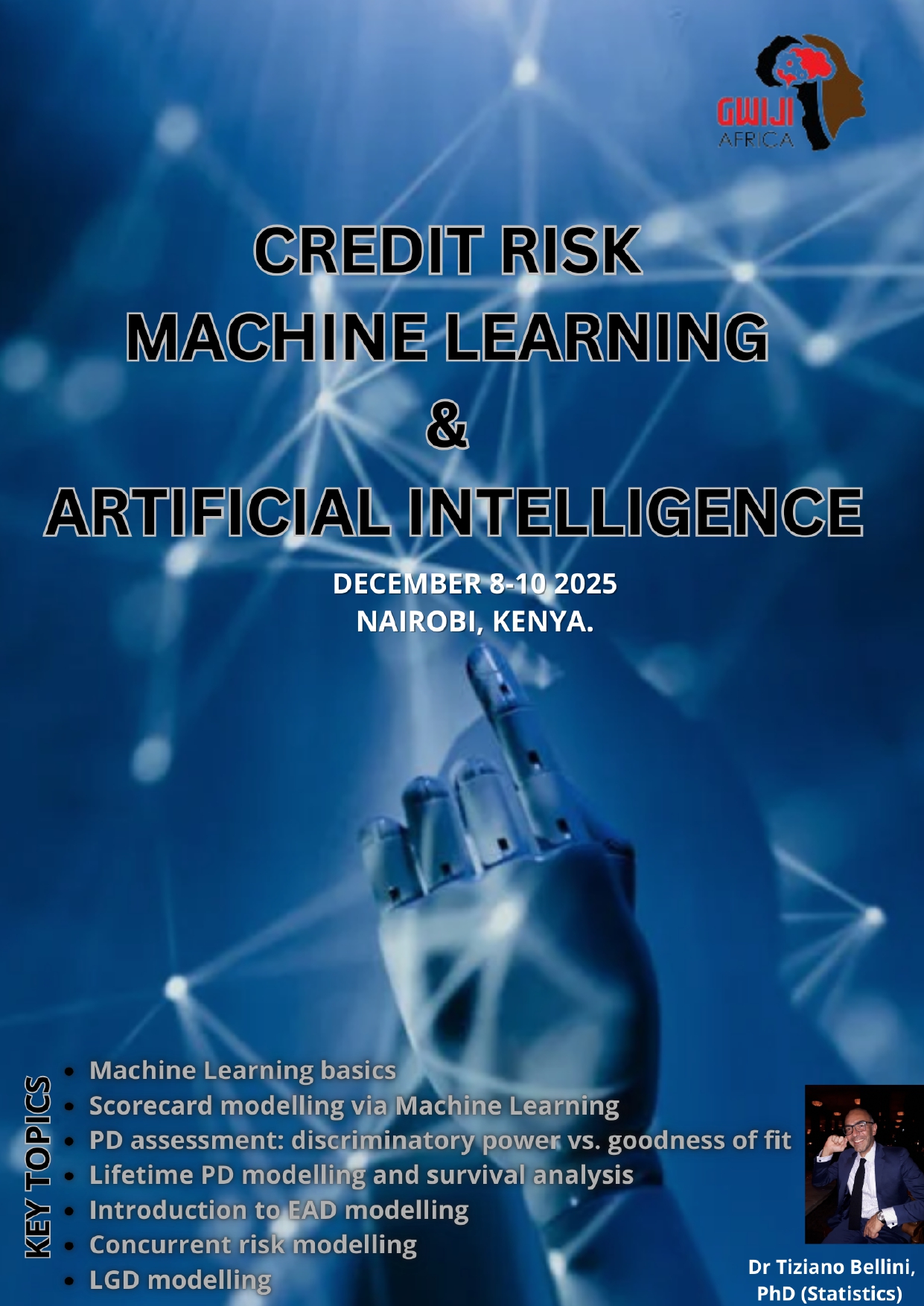Dates: 8-10 December 2025 Nairobi, Kenya.
Price :$ 1,699
Course Director : Tiziano Bellini.
Professor at the University of Bologna: Master in Quantitative Finance
Visiting professor at Imperial College in London, the London School of Economics and Political Science, , University of Passau in Germany.
A recognized expert at international level in Stress Testing and Recovery Planning, authoring multiple books on the topic:
The course will provide attendees a comprehensive overview of Machine Learning techniques applied to credit risk modelling. A hands-on approach is followed by providing both the theoretical and practical toolkit to use on a day-by-day basis. The open-source statistical software R paves the way for grasping all details required to create customized analysis.
During the first day, the key instruments used for modelling are explored. A wide use of the software R characterizes the course from the very beginning. In day one, the emphasis is on familiarizing with Machine Learning techniques and R programming. Indeed, an extensive interaction with R paves the way for the whole program.
On day two, machine learning applications will mainly focus on Probability of Default estimation based on scorecard one-year modelling and linkage between scorecard and PD calibration. Attention is mainly on classification and regression trees, bagging, boosting, and random forest. Furthermore, a time horizon expansion to encompass the entire lifetime characterizes day two. Survival analysis is introduced and a combination of machine learning techniques is explored by means of R software.
In day three, both EAD and LGD are explored. Behavioural model encompassing prepayment, overpayment and a comprehensive EAD dynamic are studied through the lenses of bagging, boosting and random forest modelling. Similarly, LGD is explored by considering the techniques explored throughout the course.
Price :$ 1,699
Course Director : Tiziano Bellini.
About the course director
Responsible of Prometeia Risk Integration and Advisory for International Markets, including Egypt since 2022. This area of expertise include:- Stress testing and Recovery Planning.
- Advisory on planning and enterprise risk management processes.
- Models & methodologies, development of simulation tools for integrated risk management
- IFRS 9, CECL, Loss forecasting, PD, LGD, EAD modelling.
Professor at the University of Bologna: Master in Quantitative Finance
Visiting professor at Imperial College in London, the London School of Economics and Political Science, , University of Passau in Germany.
A recognized expert at international level in Stress Testing and Recovery Planning, authoring multiple books on the topic:
- Stress Testing and Risk Integration in Banks, A Statistical Framework and Practical Software Guide (in Matlab and R), edited by Academic Press (2016)
- IFRS 9 and CECL Credit Risk Modelling and Validation: A Practical Guide with Examples Worked in R and SAS, edited by Academic Press (2019)
- Reverse Stress Testing in Banking, A Comprehensive, edited by De Gruyter (2021)
- Authored papers published in European Journal of Operational Research (EJOR), Computational Statistics and Data Analysis (CSDA) and other top reviewed Journals.
- Referees of Journal of Banking and Finance (Elsevier) and Journal of Applied Statistics (Taylor&Francis) and other top Journals.
- Trainer in risk management and statistics in Europe, UK, Asia, Middle East, Africa.
Course Overview
The course will provide attendees a comprehensive overview of Machine Learning techniques applied to credit risk modelling. A hands-on approach is followed by providing both the theoretical and practical toolkit to use on a day-by-day basis. The open-source statistical software R paves the way for grasping all details required to create customized analysis.
During the first day, the key instruments used for modelling are explored. A wide use of the software R characterizes the course from the very beginning. In day one, the emphasis is on familiarizing with Machine Learning techniques and R programming. Indeed, an extensive interaction with R paves the way for the whole program.
On day two, machine learning applications will mainly focus on Probability of Default estimation based on scorecard one-year modelling and linkage between scorecard and PD calibration. Attention is mainly on classification and regression trees, bagging, boosting, and random forest. Furthermore, a time horizon expansion to encompass the entire lifetime characterizes day two. Survival analysis is introduced and a combination of machine learning techniques is explored by means of R software.
In day three, both EAD and LGD are explored. Behavioural model encompassing prepayment, overpayment and a comprehensive EAD dynamic are studied through the lenses of bagging, boosting and random forest modelling. Similarly, LGD is explored by considering the techniques explored throughout the course.
Who should attend
- Risk managers: model developers and independent model validators.
- Auditors with focus on quantitative methods and applications.
- Finance professionals with focus on advanced modelling.
- Credit experts leveraging advanced techniques

